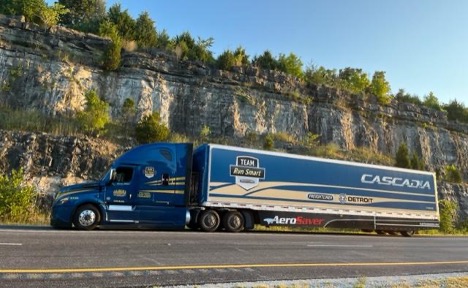.jpg.aspx)
out·li·er /ˈoutˌlīər/ noun
a person or thing situated away or detached from the main body or system.
"less accessible islands and outliers"
a person or thing differing from all other members of a particular group or set.
"an outlier in Faulkner's body of work"
As many of you know, I have a background in automotive racing; primarily on an oval track. When racing, I always looked at averages; average lap times, average tire temperatures, and in some cases, average fuel mileage. And when I got all of my averages in line, it led to more victories.
Many times, I’m called in to meet with drivers from fleets for training on maximizing the technology offered in today's trucks. It's funny that over time, I start hearing the same comments over and over. The number one comment is about the “one hill”. It seems as if there is always one hill that the drivers are dissatisfied with on the performance of their equipment. When I hear them, I think “Do you put all of your miles in on this ‘one hill’?”. Even if the driver consistently operated on the “one hill”, half of that hill is still downhill. Typically my response is “The last time I checked, most of our country is fairly flat. And where it’s not flat, half of that remaining section of roadway is downhill.” So with this in mind; what percentage of your day/week/month/year is actually uphill?
My thoughts are that going uphill is, as in the title of this article, actually an outlier, that gets too much attention considering the small percentage of time that going uphill takes from all of your other daily driving activities. Concentrating on being efficient on the flat terrain makes up most of your day. So, that makes it the area that should receive the most attention in regards to how a truck is powered and geared. Granted, the going uphill section is always the most memorable, but in terms of overall efficiency, it should not take the highest priority.
My current truck is equipped with a 6x2 liftable pusher which is known as the Hendrickson OPTIMAAX Suspension System. In this case, when my truck is light or empty, the lead axle of the tandem is not powered and lifts whenever it is not needed to support the load. This saves on fuel and also on toll roads where you are charged by the axle. When talking about my new truck with the OPTIMAAX liftable axle to other drivers, the first question that is usually asked is “How does it perform in the snow?”. The immediate reaction in my own mind is “How many days a year do you actually drive in the snow where this could pose any operational difficulty?”. The reality of the situation, from my experience in the snow, is it does quite well. Ultimately, does it do as well as a truck that sends power to two axles? The obvious answer is, “Probably not in terms of total traction compared to a true tandem axle assembly.” With that being said, I have actually found that it seems to do better than a traditional tandem when loaded lightly and all of the weight is placed on one axle, instead of two.
Still, the question remains; “How many days a year does it snow to the point where this would create any kind of a handicap for your operation?”. In this case, operating in snowy conditions may also be an outlier.
For efficiency in my operation, I also employ wide-base single tires. Tires are also met with much resistance by many drivers and fleet owners. “What do you do if you get a flat or a blowout?” is often asked. First of all, blowouts are generally caused by operating a tire below its recommended inflation pressure. I employ a tire monitor to keep a constant check on all 10 of my tires on the truck and trailer. This eliminates much of this worry because all of the pressures are displayed on a dashtop monitor. A warning tone is emitted if a tire's pressure drops 5 psi below my desired setting. I carry an air hose along to be able to refill slow leaks and a professional tire plug set for more substantial temporary tire repairs. Through these steps, it has made flat tires and blowouts also fit into the category of outliers.
The list of outliers can be quite extensive and can cut into the overall profitability of your business. Pay attention to those outliers that are getting too much of your attention when looking to spec a new truck.
Until next time, drive safe and profitable.